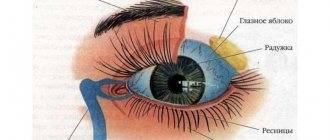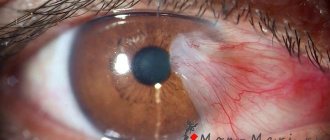People may occasionally experience tremors in their eyes.
If this is an isolated case and there are no signs of any disease, the condition does not belong to the pathological process.
If you experience frequent tremors, it is recommended to undergo a full examination by an ophthalmologist and neurologist. This sign indicates a pathology of the visual organs or a disorder of the central nervous system. Since the disease can be serious, it is recommended not to ignore the symptom or self-medicate.
Cause
There are various possible causes for the condition:
- disorders in the central nervous system or peripheral nervous system;
- injuries in the eye and or skull area;
- changes in the retina of the eyes;
- circulatory disorders in the organs of vision or brain;
- disorders in the cervical spine;
- prolonged stress;
- slight changes or complete atrophy of the optic nerve;
- the formation of toxic products in the blood that appear as a result of poisoning or infectious disease;
- decreased amount of oxygen in the blood;
- alcoholism, drug addiction, excessive tobacco use;
- prolonged work at the computer, frequent use of the telephone;
- vegetative-vascular dystonia;
- increase or decrease in blood pressure;
- inflammatory processes in the organs of vision or brain.
It's like water in my eyes
Let's look at some of the symptoms of eye diseases.
Symptoms of diseases according to eye sensations
Have you ever had small floating particles appear before your eyes? It seems as if something has gotten into your eye, although you don’t feel anything.
If you rub your eyes, trying to remove an invisible speck, the “floaters” will not disappear or will get even worse. Because it is not a speck of dust or a speck. More like something like cloudiness or condensation.
Floating particles can be specks, cobwebs, hairs, dust particles or tiny insects that appear in your field of vision. They are not on the surface of the eye, so when you try to erase them from there, you fail.
These are the smallest components of the vitreous humor, the jelly-like filling of the eyeball. Probably, such eye sensations as “floaters” occur when you look directly at something bright and light, for example, at a white wall or a clean, clear sky.
Usually floating particles disappear after a few seconds or minutes, appear and disappear when you turn your head. Over time, people simply stop noticing them.
Floaters before eyes
Are you tired of "flies"? You are not alone; almost all of us experience them from time to time. They occur more often in people with severe myopia, as well as in those who have had eye surgery.
This vision usually occurs for the first time in adolescence and is repeated more often as they mature. This happens because over the years the vitreous body moves away from the retina.
Small gel-like grains separate and float in the person’s field of vision.
“Floaters” are another annoying sign and symptom of aging. But sometimes they indicate serious problems, especially if they suddenly appear much more than usual, or they increase in size if you notice them by looking at a light and dark surface or at one point.
All these are early symptoms of cataracts, inflammation, hemorrhage and other dangerous disorders. Sometimes the unexpected appearance of “floaters” before the eyes indicates something truly dangerous - a rupture or detachment of the retina.
When a retinal detachment occurs, immediate medical attention is required or the risk of blindness becomes frighteningly real.
Flashes before my eyes
Have you ever received a hard blow to the head? Then, most likely, flashes or stars appeared before your eyes, in medical language called phosphenes.
They occur when you suddenly open or close your eyes, most often in your peripheral vision, and last for several seconds.
Some say they look like exploding stars, others describe them as a "rain of sparks."
The condition in which flashes appear in the eyes is called photopsia. It is often encountered by students, writers, and those who go to bed late or suffer from insomnia. Photopsia occurs in those who hit their head, sneeze, or rub their eyes vigorously.
An increase in the number of flashes—or flashes along with floaters—can be a warning sign of a retinal tear or detachment, as well as severe vitreous detachment, all of which require immediate medical attention. And even after treatment, outbreaks continue to appear for several months.
Migraine with aura
Everyone has rare flashes before their eyes, and in this case there is no need to worry. This is mainly due to age.
But if they occur frequently enough, you might suspect high blood pressure, especially when the flare-ups occur when you stand up suddenly. They are harbingers of headaches in those who suffer from migraines.
As a matter of fact, this is the most common accompaniment of this disorder - an aura that occurs when the blood vessels of the brain spasm.
Recent large-scale medical studies have shown that women who suffer from migraines preceded by an aura are at risk of stroke or heart attack. Scientists have not yet tracked the same dependence in men.
Surprisingly, some people who suffer from migraines experience an aura, but not necessarily a headache afterwards (migraines are not always accompanied by headaches). In addition to flashes before the eyes, this type of migraine—atrial fibrillation (or silent migraine)—can cause visual disturbances, nausea, or nasal blockage.
Treatment of diseases based on eye sensations
If suddenly something happens to your vision, especially when the outlines of objects begin to double or blur, call a doctor or call an ambulance as soon as possible. In the case of head or facial injury, this symptom may accompany a concussion. Even if there was no external influence, a medical examination is necessary.
Other articles on this topic:
Diagnostics
To determine the cause of trembling in the eyes, it is recommended to undergo a complete diagnosis of the visual organs and brain.
It is carried out in several stages:
- Anamnesis collection. This is information obtained from the words of the patient and his close relatives.
- General examination of the superficial tissues of the organs of vision.
- Examination of the fundus using instillation of a solution that disrupts the accommodation process. The doctor diagnoses the condition of the lens, eye chambers, and retina.
- Measurement of arterial and intraocular pressure.
- Measuring visual acuity using special ophthalmological tables.
- Laboratory testing, including a general blood and urine test, blood biochemistry, testing for the presence of infections and viruses.
- , MRI to check the condition of the internal structures of the brain and eyes.
Fluid in the eyes
The eyeball produces fluid that nourishes the lens and structures of the anterior chamber.
Intraocular pressure depends on how freely it moves through the anterior chamber.
Its increase accompanies the “green eye disease” - glaucoma. Due to stagnation of fluid, the cornea becomes dull, the pupil dilates, and the lens turns green, deprived of nutrition. Glaucoma also has a latent form and is not always accompanied by high IOP.
Risk group
People who are predisposed to accumulation of ocular fluid and high IOP are:
- with diseases of the thyroid, pancreas, pituitary gland, diabetes;
- with displacement of the lens;
- with severe myopia;
- over 40 years of age;
- with hereditary predisposition.
The causes of stagnation or excess aqueous humor differ between types of glaucoma.
Classification of glaucoma
By origin:
- primary - develops after 40 years, is associated with pathological processes inside the eyeball;
- secondary - occurs after injuries, illnesses, operations.
According to the mechanism of increased eye pressure:
By eye pressure level:
- hypertensive;
- normotensive.
According to the course of the disease:
- stable - the patient’s condition does not change for six months;
- unstabilized - deterioration with repeated examinations.
Stages of optic nerve damage:
- initial - no noticeable changes in the visual field;
- developed - narrowing 10° from the fixation point;
- far advanced—limited field of view to 15°;
- terminal - blindness, sometimes light perception is preserved.
Secondary glaucoma occurs with cyclic crises.
Treatment
At the initial stage of the process, eye drops are prescribed:
- stimulating fluid outflow
- suppress its production.
They can also be combined.
The attack is relieved with drops of Pilocarpine, Timolol, Betaxolol. If after 20 hours the IOP does not decrease, surgery is performed:
- trabeculectomy - surgical formation of a drainage channel;
- iridectomy - partial excision of the iris;
- Optociliary neurectomy - removal of part of the ciliary optic nerve.
Surgical treatment is also prescribed if the conservative method is ineffective.
Complications
Difficulties after surgery:
- overgrowing of the drainage channel;
- hemorrhage;
- time in the seam that allows moisture to pass through;
- deviation of the outlet channel.
Untreated glaucoma will lead to gradual loss of vision. Glaucomocyclic crisis causes irreversible changes in tissues, during which it is impossible to reduce the pressure. The patient loses an eye.
Prevention
To prevent trembling in the eyes, it is recommended to adhere to the following rules:
- annual examination by an ophthalmologist to prevent the development of serious diseases;
- if the patient has ophthalmological diseases, it is recommended to undergo timely treatment and periodic diagnostics to check for various changes;
- timely treatment of systemic diseases;
- elimination of all bad habits in the form of alcoholism, drug addiction, excessive tobacco use;
- proper nutrition containing vitamins, microelements, minerals;
- playing sports to maintain normal blood circulation in all organs and tissues.
Trembling in the eyes may indicate slight fatigue or the presence of a serious illness. Therefore, it is recommended to be examined by a doctor if symptoms appear. Treatment must be carried out according to the recommendations of a specialist, since many drugs can cause adverse reactions.
When should you make an appointment with a doctor?
Threads, worms, and flies are not always dangerous. With normal acuity of perception, there is no reason for concern. However, if there is decreased vision or diabetes, you should consult a doctor. They will be a sign of negative changes inside the eye. For example, diabetic retinopathy.
Against the background of such manifestations, myopia develops intensively. Therefore, if your vision deteriorates, you should immediately seek help. In general, the following circumstances are grounds for making an appointment:
- if the effects do not go away within a few days,
- when they arose as a result of impact,
- if the threads are accompanied by spatial disorientation, headaches,
- in the presence of severe fatigue, drowsiness, loss of strength.
Conclusion
Why is my vision blurry? The cause may be serious chronic pathologies, eye diseases, infections, physiological conditions and the influence of external factors.
If your vision becomes blurry after exercising, due to hunger or fatigue, your visual function will be restored after resting and eating a snack.
But if you are sick with a serious illness, your vision has deteriorated sharply, your eyes see cloudy, the image is constantly blurry - be sure to visit an ophthalmologist and get examined!
Associated symptoms
Absolutely healthy people rarely experience blurred vision, if only temporarily under the influence of external factors. Patients for whom blurred vision is a common condition most often suffer from some kind of disease.
There are additional symptoms:
- Black dots, stars, dark or floating circles before the eyes;
- Headache;
- Feeling of pressure on the eyes;
- Symptoms of vegetative-vascular dystonia;
- Nausea;
- Noise and ringing in the ears;
- Painful reaction to bright light;
- Redness and irritation.
In this case, the blurred vision is absolutely due to an illness or pathological condition. Let's look at the main causes of cloudy and blurry vision.











